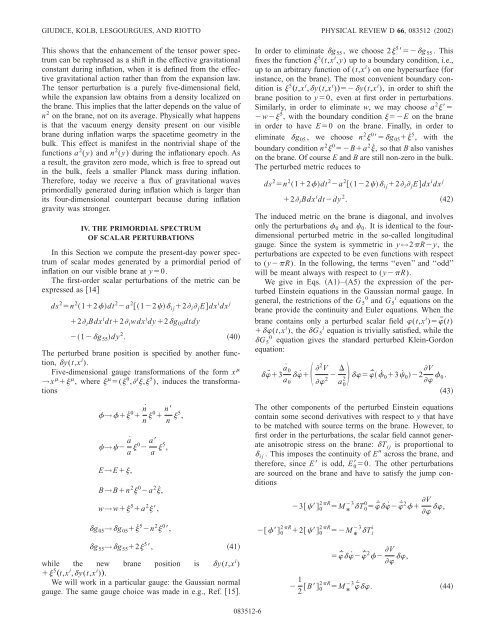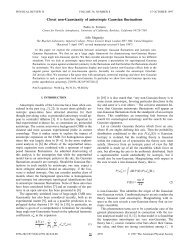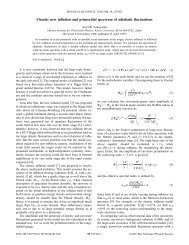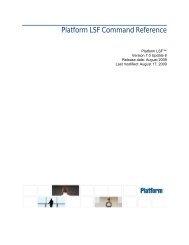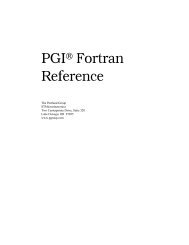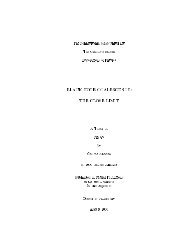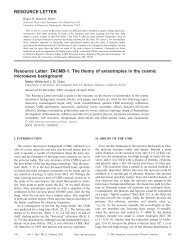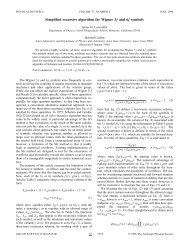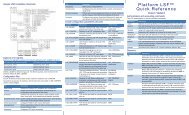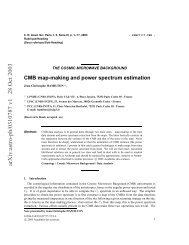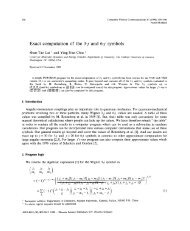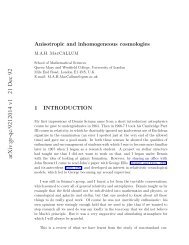Transdimensional physics and inflation - American Physical Society
Transdimensional physics and inflation - American Physical Society
Transdimensional physics and inflation - American Physical Society
You also want an ePaper? Increase the reach of your titles
YUMPU automatically turns print PDFs into web optimized ePapers that Google loves.
GIUDICE, KOLB, LESGOURGUES, AND RIOTTO<br />
This shows that the enhancement of the tensor power spectrum<br />
can be rephrased as a shift in the effective gravitational<br />
constant during <strong>inflation</strong>, when it is defined from the effective<br />
gravitational action rather than from the expansion law.<br />
The tensor perturbation is a purely five-dimensional field,<br />
while the expansion law obtains from a density localized on<br />
the brane. This implies that the latter depends on the value of<br />
n 2 on the brane, not on its average. <strong>Physical</strong>ly what happens<br />
is that the vacuum energy density present on our visible<br />
brane during <strong>inflation</strong> warps the spacetime geometry in the<br />
bulk. This effect is manifest in the nontrivial shape of the<br />
functions a 2 (y) <strong>and</strong> n 2 (y) during the <strong>inflation</strong>ary epoch. As<br />
a result, the graviton zero mode, which is free to spread out<br />
in the bulk, feels a smaller Planck mass during <strong>inflation</strong>.<br />
Therefore, today we receive a flux of gravitational waves<br />
primordially generated during <strong>inflation</strong> which is larger than<br />
its four-dimensional counterpart because during <strong>inflation</strong><br />
gravity was stronger.<br />
IV. THE PRIMORDIAL SPECTRUM<br />
OF SCALAR PERTURBATIONS<br />
In this Section we compute the present-day power spectrum<br />
of scalar modes generated by a primordial period of<br />
<strong>inflation</strong> on our visible brane at y0.<br />
The first-order scalar perturbations of the metric can be<br />
expressed as 14<br />
ds 2 n 2 12dt 2 a 2 12 ij 2 i j Edx i dx j<br />
2 i Bdx i dt2 i wdx i dy2g 05 dtdy<br />
1g 55 dy 2 .<br />
40<br />
The perturbed brane position is specified by another function,<br />
y(t,x i ).<br />
Five-dimensional gauge transformations of the form x <br />
→x , where ( 0 , i , 5 ), induces the transformations<br />
→˙ 0 ṅ n 0 n<br />
n 5 ,<br />
→ ȧ a 0 a<br />
a 5 ,<br />
E→E,<br />
B→Bn 2 0 a 2 ˙ ,<br />
w→w 5 a 2 ,<br />
g 05 →g 05 ˙ 5n 2 0 ,<br />
In order to eliminate g 55 , we choose 2 5 g 55 . This<br />
fixes the function 5 (t,x i ,y) up to a boundary condition, i.e.,<br />
up to an arbitrary function of (t,x i ) on one hypersurface for<br />
instance, on the brane. The most convenient boundary condition<br />
is 5 „t,x i ,y(t,x i )…y(t,x i ), in order to shift the<br />
brane position to y0, even at first order in perturbations.<br />
Similarly, in order to eliminate w, we may choose a 2 <br />
w 5 , with the boundary condition E on the brane<br />
in order to have E0 on the brane. Finally, in order to<br />
eliminate g 05 , we choose n 2 0 g 05 ˙ 5, with the<br />
boundary condition n 2 0 Ba 2 ˙ , so that B also vanishes<br />
on the brane. Of course E <strong>and</strong> B are still non-zero in the bulk.<br />
The perturbed metric reduces to<br />
ds 2 n 2 12dt 2 a 2 12 ij 2 i j Edx i dx j<br />
2 i Bdx i dtdy 2 .<br />
42<br />
The induced metric on the brane is diagonal, <strong>and</strong> involves<br />
only the perturbations 0 <strong>and</strong> 0 . It is identical to the fourdimensional<br />
perturbed metric in the so-called longitudinal<br />
gauge. Since the system is symmetric in y↔2Ry, the<br />
perturbations are expected to be even functions with respect<br />
to (yR). In the following, the terms ‘‘even’’ <strong>and</strong> ‘‘odd’’<br />
will be meant always with respect to (yR).<br />
We give in Eqs. A1–A5 the expression of the perturbed<br />
Einstein equations in the Gaussian normal gauge. In<br />
general, the restrictions of the G 0 5 <strong>and</strong> G i 5 equations on the<br />
brane provide the continuity <strong>and</strong> Euler equations. When the<br />
brane contains only a perturbed scalar field (t,x i )¯(t)<br />
(t,x i ), the G i 5 equation is trivially satisfied, while the<br />
G 0 5 equation gives the st<strong>and</strong>ard perturbed Klein-Gordon<br />
equation:<br />
¨ 3 ȧ 0<br />
˙<br />
a 0<br />
2 V<br />
2 a 0<br />
2 ¯˙ V<br />
˙ 03˙ 02<br />
0 .<br />
43<br />
The other components of the perturbed Einstein equations<br />
contain some second derivatives with respect to y that have<br />
to be matched with source terms on the brane. However, to<br />
first order in the perturbations, the scalar field cannot generate<br />
anisotropic stress on the brane: T ij is proportional to<br />
ij . This imposes the continuity of E across the brane, <strong>and</strong><br />
therefore, since E is odd, E 0 0. The other perturbations<br />
are sourced on the brane <strong>and</strong> have to satisfy the jump conditions<br />
3 0 2R M * 3 T 0 0 ¯˙ ˙ ¯˙ 2 V<br />
,<br />
0 2R 2 0 2R M * 3 T i<br />
i<br />
PHYSICAL REVIEW D 66, 083512 2002<br />
g 55 →g 55 2 5 ,<br />
41<br />
while the new brane position is y(t,x i )<br />
5 „t,x i ,y(t,x i )….<br />
We will work in a particular gauge: the Gaussian normal<br />
gauge. The same gauge choice was made in e.g., Ref. 15.<br />
083512-6<br />
¯˙ ˙ ¯˙ 2 V<br />
,<br />
1 2 B 0 2R M * 3 ¯˙ .<br />
44


